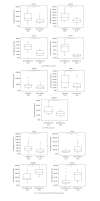Comparative gene expression profiling in human cumulus cells according to ovarian gonadotropin treatments
- PMID: 24151596
- PMCID: PMC3786475
- DOI: 10.1155/2013/354582
Comparative gene expression profiling in human cumulus cells according to ovarian gonadotropin treatments
Abstract
In in vitro fertilization cycles, both HP-hMG and rFSH gonadotropin treatments are widely used to control human follicle development. The objectives of this study are (i) to characterize and compare gene expression profiles in cumulus cells (CCs) of periovulatory follicles obtained from patients stimulated with HP-hMG or rFSH in a GnRH antagonist cycle and (ii) to examine their relationship with in vitro embryo development, using Human Genome U133 Plus 2.0 microarrays. Genes that were upregulated in HP-hMG-treated CCs are involved in lipid metabolism (GM2A) and cell-to-cell interactions (GJA5). Conversely, genes upregulated in rFSH-treated CCs are implicated in cell assembly and organization (COL1A1 and COL3A1). Interestingly, some genes specific to each gonadotropin treatment (NPY1R and GM2A for HP-hMG; GREM1 and OSBPL6 for rFSH) were associated with day 3 embryo quality and blastocyst grade at day 5, while others (STC2 and PTX3) were related to in vitro embryo quality in both gonadotropin treatments. These genes may prove valuable as biomarkers of in vitro embryo quality.
Figures




References
-
- Trew GH, Brown AP, Gillard S, et al. In vitro fertilisation with recombinant follicle stimulating hormone requires less IU usage compared with highly purified human menopausal gonadotrophin: results from a European retrospective observational chart review. Reproductive Biology and Endocrinology. 2010;8, article 137 - PMC - PubMed
-
- van Wely M, Kwan I, Burt AL, et al. Recombinant versus urinary gonadotrophin for ovarian stimulation in assisted reproductive technology cycles. A cochrane review. Human Reproduction Update. 2012;18(2):p. 111. - PubMed
-
- Hutt KJ, Albertini DF. An oocentric view of folliculogenesis and embryogenesis. Reproductive BioMedicine Online. 2007;14(6):758–764. - PubMed
-
- Albertini DF, Combelles CMH, Benecchi E, Carabatsos MJ. Cellular basis for paracrine regulation of ovarian follicle development. Reproduction. 2001;121(5):647–653. - PubMed
Publication types
MeSH terms
Substances
LinkOut - more resources
Full Text Sources
Other Literature Sources
Research Materials
Miscellaneous

